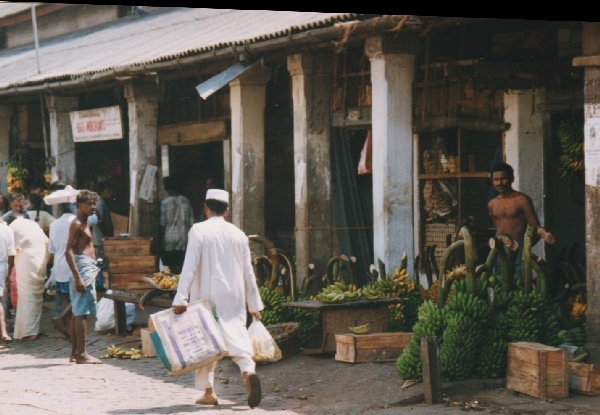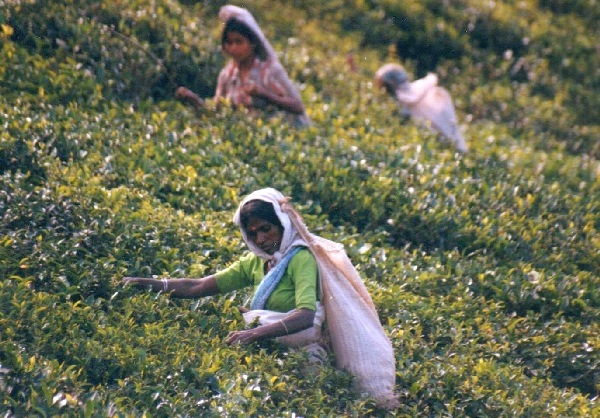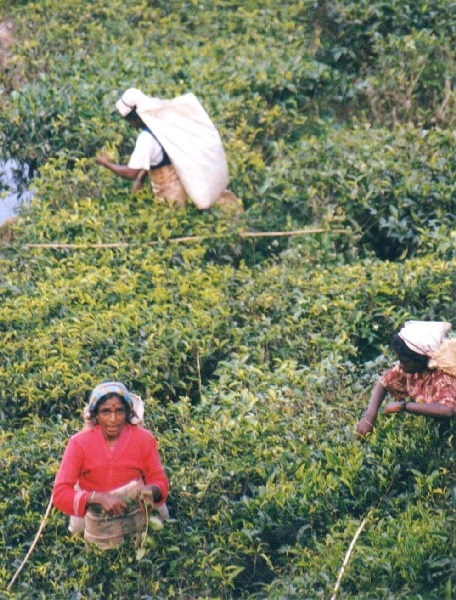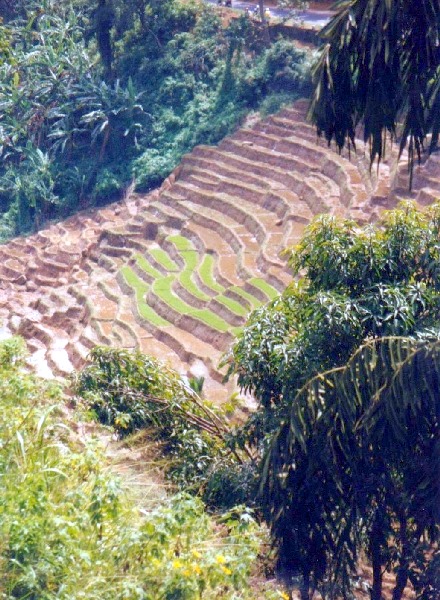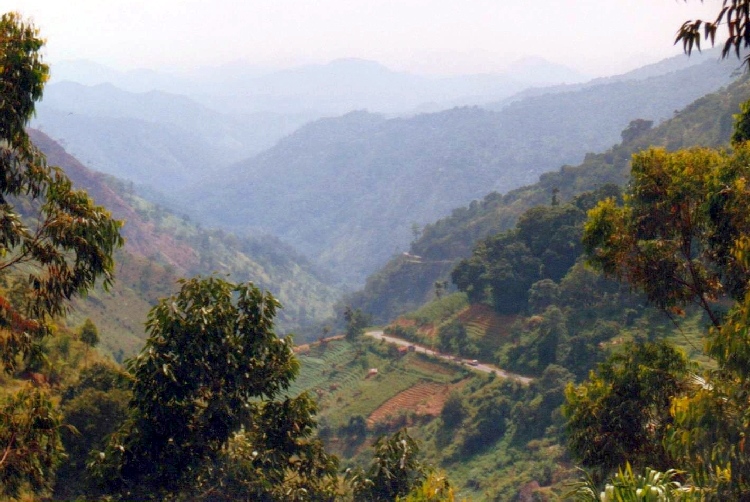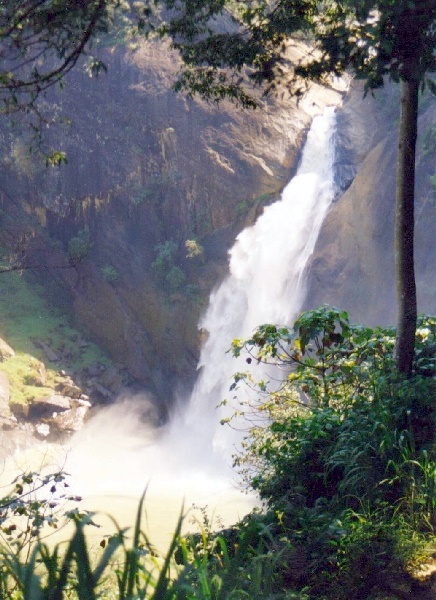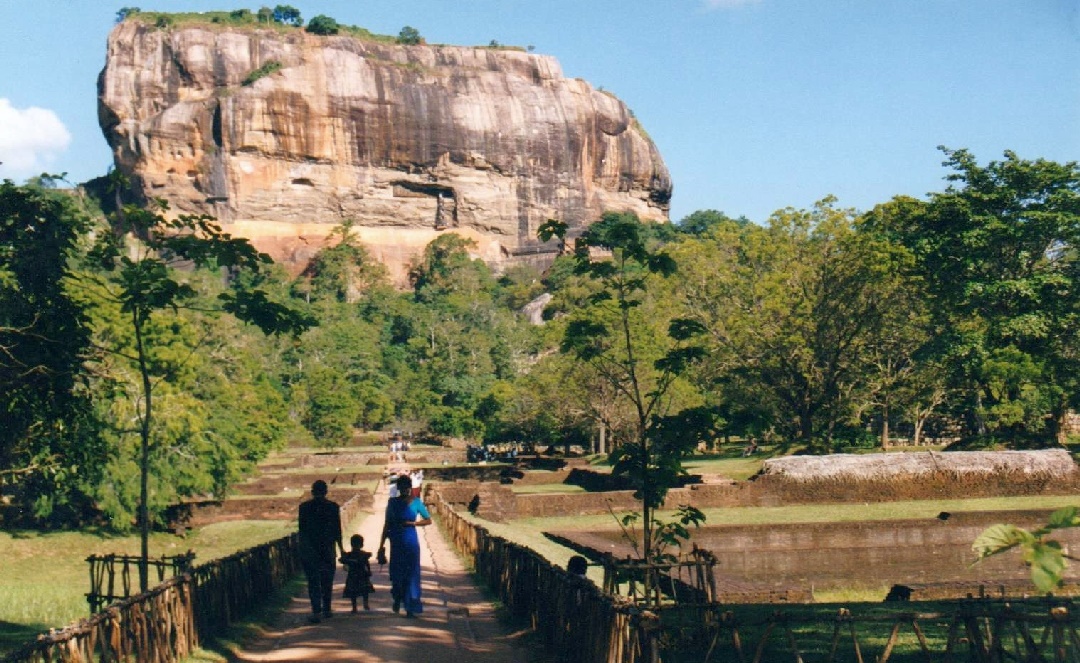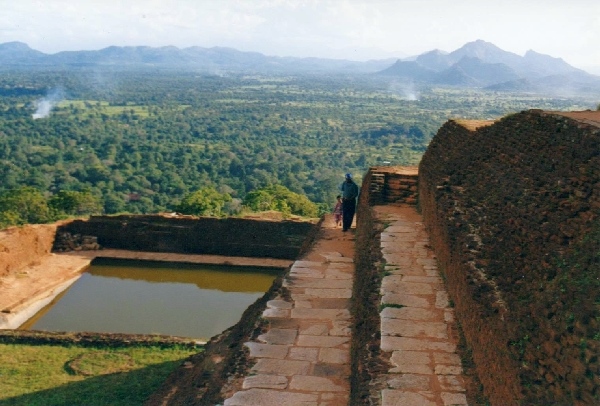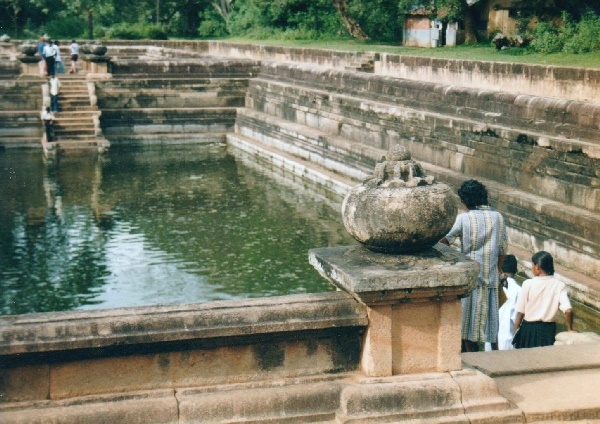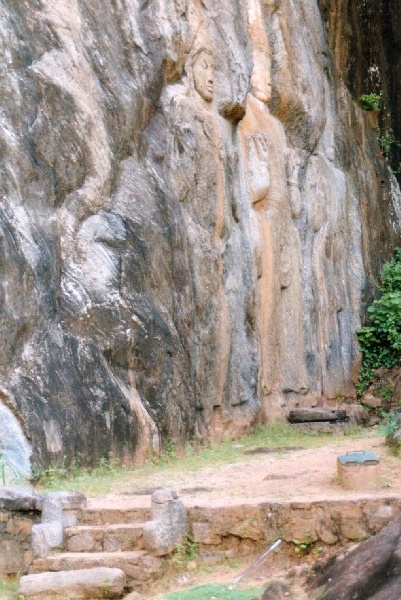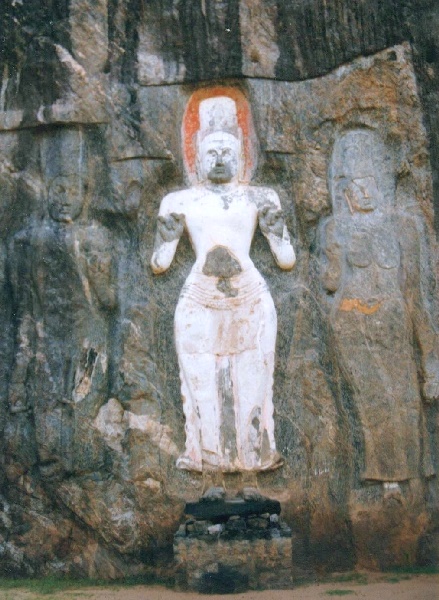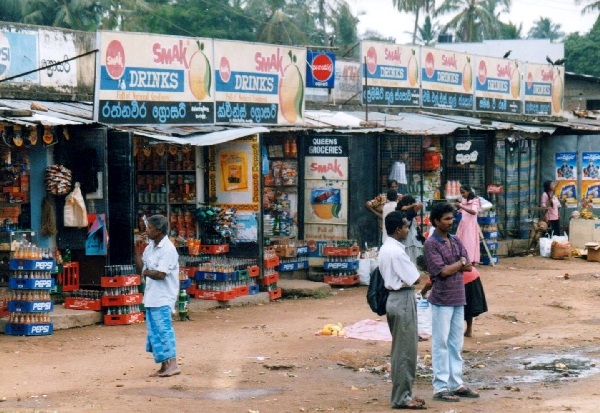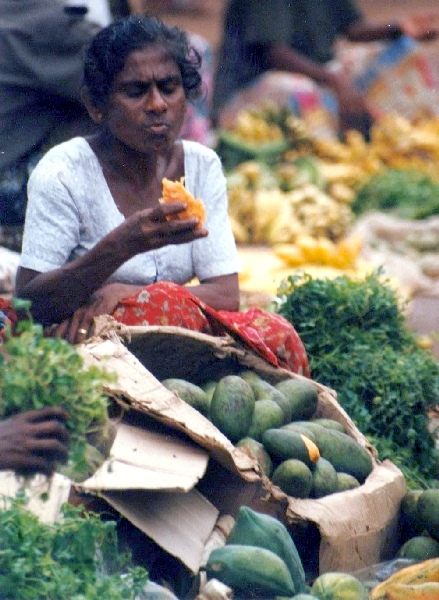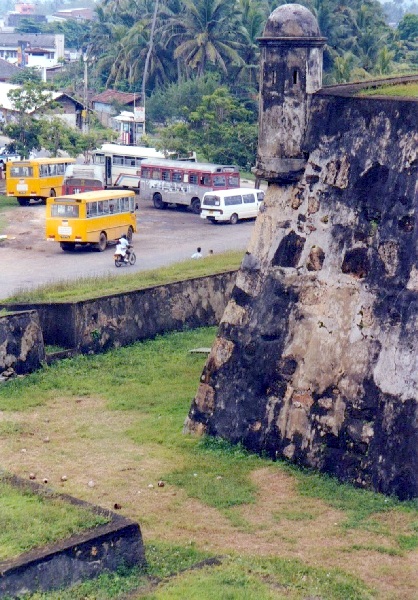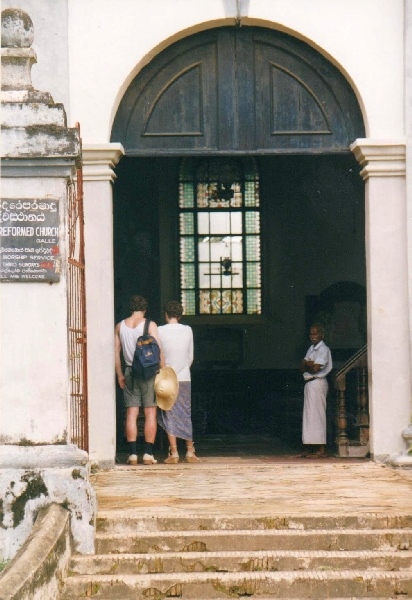World traveler Clown Tom Bolton
Adventure stories & photos

Tom’s travels in Sri Lanka aka Ceylon
Colombo, capital of Sri Lanka
I went to Sri Lanka, formerly known as Ceylon, in early 1999 arriving in the capital of Colombo. It is a fairly large island with a history of culture beyond its size. It’s true that it was not as cheap or intense as India as I had heard some travelers complain but this was part of its charm. One doesn’t have the crushing poverty, pollution or over-population of large Indian cities and while nominally more expensive, I found the quality and thus the value of what one got for his money better although one does need to watch out for the occasional restaurant that will suddenly tack on not only a 10% service fee but a 10% tax in addition.
Many travelers go to Sri Lanka only so that they can renew their Indian visas and miss out on truly seeing one of the world’s most interesting destinations. Colombo has a couple of dusty museums but not much else of interest for travelers. Much nicer were the beaches and spectacular highlands, graced by incredible nature and many ruins. Colombo did have some attractive old colonial buildings around that were owned by the local elite or government agencies. I’m not sure what these buildings were used for in Colombo but it represents the style of older architecture.
Street scenes in Colombo
Most of the short time I spent in Colombo was just walking around taking in everyday life. This included watching people in markets and shops. Having been to India a couple of times it was sort of a standard I used for comparison. There are many similarities in the cultures. People look and dress similar but the pace of life was definitely less hectic in Colombo than in major Indian cities.
Sri Lanka security
A common site throughout Colombo was the many police check points due to the ongoing civil conflict between the Tamils and Sinhalese. Westerners were not targeted by either side but bombings are of course indiscriminate. But everything is relative, many more people died in the tsunami and the risk of dying in a traffic accident must have been higher than the chance of getting blown up. That said; most of northern Sri Lanka and the eastern coast were off limits during my visit.
There was supposed to be a truce on at the time in Sri Lanka but that meant things were just smoldering rather than on a high flame. It was hard to have any discussion about the “Tamil problem” as the Sinhalese liked to call it because both sides tended to be fanatic about their own side’s righteousness and the diabolical nature of the other. The following photos were actually made at the Polonnaruwa ruins in the highland but is fairly typically except that there they actually let me take a photo, an action that probably wouldn’t have been tolerated in the capital.
Other troubles in Sri Lanka paradise
Besides the fluctuating security concerns there was something else that bothered me in this otherwise amazing country. Despite such a wealth of culture, the population seemed to have an inferiority complex. And a Sri Lankan would support a fellow citizen no matter what. There was a crazy local guy at one beach who I saw more than once approach tourists and threaten to kill them and shout endless insults of the worse kind at them and their kids. Not only did the local restaurant and hotels owners do nothing, they warned the tourists that they would support the crazy guy if things turned violent.
I met an English guy who stopped a young local from trying to rape and drown his girlfriend. Although he knew the people in this village well, having visited there regularly for 15 years, they threatened to hurt him if he laid a finger on the attacker. Things were always perceived as Sri Lankan vs. outsiders unlike most of the world where the alliances would be respectable people vs. criminals regardless of the nationalities involved. I would not warn people off from going to Sri Lanka for this reason alone but it should be kept in mind if altercations happen.
Tea production in Sri Lanka
The next couple of photos show tea plantations in the highlands for which Sri Lanka is world famous. I saw workers there spraying the plants with what they describe as “vitamins” which sounds like something good. I suspect pesticides and herbicides were actually used which is not so cool. The English actually built up most of the plantations and after a fungus decimated the coffee plants in the 1870’s, tea became the main cash crop.
Tea picking takes some skill
Picking tea is harder than it looks. One must concentrate on getting just the right leaves, without damaging them, while keeping one’s footing on the steep, slippery slopes. I fell more than once even with my trekking boots on which was a good laugh for the workers. I was told the traditional baskets in Sri Lanka have mostly been replaced by the cheaper rice sacks although there is a higher tendency of damaged leaves.
Typical tea plantation in Sri Lanka
Workers would pick their way across the plantation so that they returned after 7 – 10 days to get the newest leaves. Crazy what one pays for some of the better teas in the west as the pickers in Sri Lanka worked all day for around 2 US dollars and the supervisors got 100 dollars a month. Lots of competition from places like Kenya had driven the wages down was the explanation I got. Although the sun was fierce, it was usually afternoon before it burned the heavy fog away.
Sri Lanka nature
The high mountains of the interior catch the clouds and the monsoon rains make much of Sri Lanka as close to a tropical paradise as one could imagine. These are wild elephants in a swampy part of Rahunu National Park in the southeastern part of the county. One often saw domesticated elephants, which had much pink rather than grey pigmentation. When I grew up, it was a cliché for someone to claim to have seen a pink elephant when they were drunk suggesting that they must have been hallucinating but hey, they really do exist. Sri Lanka, like most countries, has lost much of its wild lands over the last decades yet it is claimed that a king proclaimed the first wild animal sanctuary in the world here more than 2000 years ago. It’s just a coincidence that this photo looks similar to the above tea plantation. Both are green and fertile but the park had a swamp and wildlife.
Tissamaharama, Rahunu National Park
To visit the extensive Rahuna National Park I stayed in Tissamaharama and arranged a tour through my guesthouse. Our jeep was very old and they didn’t dare to stop the motor since it might not start again. This made it difficult to keep a low profile and when one did see animals, the vehicle was shaking so much that taking photos was next to impossible. Despite this, we got very close to some elephants and saw crocodiles, wild boar, an eagle, jackals, monkeys, deer and lots of birds. The guide pointed out what should be a leopard a long ways off but it could have been anything for all I could see. Later, people in a jeep ahead of us showed me their video of a leopard crossing the road right in front of them, so maybe our guide was right.
Haputale, Ella, Bandulla & Nuwara Eliya
From Rahuna Park I continued north to the towns of Haputale, Ella, Bandulla and Nuwara Eliya, areas that were very green and had great mountainous views. Much of the jungle there has been cut away for agriculture and terraced for rice production. Since it is such a staple of the Sri Lankan diet, one would expect to find good rice but I found it to have an unlikable musty flavor and the texture was as if it had been well over-cooked. I did enjoy what they called string hoppers, which were small tangled balls of noodles usually served with a coconut curry for breakfast. Terraces were used for other crops including tea. But tea needs less standing water. Thus the horizontal sections were narrower and the rest slanted to let water run off rather than collect.
Trains & buses transportation
The best way to get most anywhere is Sri Lanka is by bus but the old train through these sections of the highlands is very nostalgic as it slowly rattles its way along. Unfortunately, The terrain makes it impossible to have many routes in the highlands. One can enjoy the views, eat some local snacks like spicy fried balls of lentils called wadis and chat with the people. Another advantage is that trains rarely fall off the sides of mountains like buses seem to do in such countries. I’m not sure if Sri Lanka has a better safety record on this matter than say Peru or if the accidents just don’t get much media attention. Most of the mountain roads in Sri Lanka did seem to be properly paved and wide enough for 2 vehicles from my experience.
Highland scenery in Sri Lanka, Horton Plains
Below is a typical scenic view one would see in this section of the highlands of Sri Lanka. There are a couple of places especially known for their spectacular views. One is to climb the mountain know as Adams Peak. It is a pilgrimage site and people tend to start up early in the morning to catch the sunrise at the top. It is very cold and I had heard that it was pissing down rain when I was in the area so I passed on this adventure. More accessible is the drop off from the Horton Plains known as Worlds End. I took the train to Ohiya and walked to this point but couldn’t see anything because of the clouds. The entrance fee was 12 US dollars at the time, so I strongly suggest waiting at the park entrance to ask people returning whether or not anything is visible.
Rawana Ella Falls
These images are of the Rawana Ella Falls in the southern highlands of Sri Lanka. The area is beautiful with views to the coastal plains 1000 meters below. A good day trip by foot from the village of Ella brings one to the waterfalls. As I started to follow the cascades upwards there was a group of young monks just ahead of me. It’s not a religious place but I guess a field trip to somewhere cool might help one’s meditation. There were places one could swim a bit and although it is a nature reserve, there were a number of people doing laundry.
Sri Lanka archeological sites – Dambulla
The main city in the Sri Lanka highlands is Kandy. The main cultural attraction other than the overly hyped but unspectacular Temple of the tooth (supposedly Buddha’s) is the ancient ruins around 25 kilometers north of Kandy. Dambulla is a series of caves on a hill that contains many Buddha carvings, both large and small, Hindu deities and extensive frescoes, which are worth seeing but photos are not permitted within the complex.
Here are views of the way up to Dumbella. I remember the way here as being particularly hot with lots of pesky beggars. For old tourists afraid of the walk, one could hire 4 porters who used a thrown type seat on 2 long poles to carry a person up. I guess this was a help for the handicapped but it certainly had a taint of colonial arrogance about it. Otherwise, the rest of us visitors, including many orange robed monks did the hike.
Sigiriya aka Sinhagiri
Around 20 kilometers north from Dambulla in the northern Matale District of the Central Province is Sigiriya, a UNESCO listed World Heritage Site. It has extensive ruins dominated by a fortress on top of a huge mountain sized rock. To reach the top one has to scale up some basically vertical cliffs by ways of these stairs followed by an extremely narrow pathway while holding on to a safety cable, a rather exciting adventure in itself. My thoughts were that it must have been sure madness in ancient times before they had steel cables and such to take this route during the rainy season. From the top were some good viewpoints in addition to a temple and some pools that would have been very strategic for their water supply.
The English translation of Sigiriya out of the Sinhalese is Lion Rock. Fitting since it was such a brave endeavor to scale it. There are remains of a lion sculpted around the entrance to the route up known as Lion’s Gate. The legs and paws remain but the head has long since disappeared. Maybe not a surprise since the site’s origins date back to the third century BC although that addition probably came much later.
Erotic frescos
Part way up the cliff there is an overhang, which shelters a series of ancient wall paintings of women, not hardcore but definitely erotic. Rather amazing that these frescoes have been partially damaged yet not totally defaced over the last 1500 years. Maybe this was the necessary motivation to get guys to take such a risky climb.
Polonnaruwa
Another hundred kilometers northeast from Sigiriya is the extensive ruins of the old capital Polonnaruwa. It’s another World Heritage Site from where I took the next photos. It was made the capital of Sir Lanka during the countries second kingdom after liberation from the Tamil Chola invaders from southern India in 1070. I don’t have the head for all of the twists of the local history but it is clear that the Tamil and Sinhalese cultures have clashed for a long time. Yet much of the building at Polonnaruwa was done under the Chola patronage.
I rented a bicycle from my nearby guesthouse, which came in handy since the ruins are spread out. The large Buddha figures here were some of the nicest I’ve seen anywhere. There had been a terrorist bombing at Polonnaruwa a few years previous. Now there was tight security with police checkpoints all over like one often saw in Colombo.
One got searched more than once to get into the ruins, which was unsettling considering it is a religious place but such is the result of civil conflict. Paradoxically, the famous figure of the sleeping Buddha was serenity itself. Although figures of sleeping Buddha are not unique to Sri Lanka they are rather iconic symbols in the Buddhist world. There are actually 3 Buddha figures next to each other carved out of this rock cliff. Even the monkeys seemed impressed. Also shown, the main stupa, a type of Buddhist monument.
Polonnaruwa irrigation, water management
Irrigation canals and such reserve tanks were an important part of the architectural layout of ancient Sri Lankan cities like Polonnaruwa needed because of the extreme differences in precipitation between the monsoon and dry seasons. Concepts of water management seemed to have been well thought out and applied in Sri Lanka. And while most beaches and rivers in third world countries now seem to be dumping grounds for garbage, most were surprisingly clean in Sri Lanka.
Buduruwagala Buddhist Temple
The Buddha figures at Buduruwagala in the ancient buddhist temple near the village of Wellawaya are relieves carved into the stone cliff rather than stand-alone statues. This site is nearly 200 KM south from Polannaruwa. Some of the figures’ lower bodies are rough and unfinished but it is a beautiful setting and the central figure, flanked by a group of 3 smaller figures to each side, is the largest in Sri Lanka. Here are views from both left and right.

Matara, southern coast of Sri Lanka
Matara is an important city and transit point in the south of the Sri Lanka. It turned out to be my best option to get from the south-central highlands to the coast. There were lots of colonial buildings there but the one that most impressed me was this mosque. Although not directly on the coast, a lot of trade came through Matara and Moorish seafarers have left a small but significant legacy in Sri Lanka. The Matara Fort however is just a series of old walls.
Matara outdoor market
I don’t know that the markets of Matara are any more colorful than anywhere else on Sri Lanka but I got lots of nice photos there, which are highly representative. Not surprising were the abundance of tropical fruits like ones hardly sees elsewhere. The island was simple the greenest, most tropical place I’ve encountered.
Women’s freedoms in Sri Lanka
What stands out for me in the photo below from Matara is that it is nearly all women – unaccompanied by men. The photo to the right is actually from Galle. Many of the most educated and successful Sri Lankans I met were female. For example, in Colombo I rented a room in the private house of a woman who had been a banker and her daughter was a lawyer. Compared to many cultures, the women seemed to have a little more respect in Sri Lanka and certainly aren’t cloistered away. Not that the husbands probably didn’t expect their busy wives to cook for them. But then the upper classes have servants for such things. The men didn’t leer and grab at foreign women like in India although the more popular tourist beaches attract their fair share of potential Romeos trying to get lucky.
I heard a funny story from a young Swiss girl on vacation with her German boyfriend. A Sri Lankan local tried to hit on her at the beach and instead of brushing him off; she flirted with him a bit. Some days later she and her boyfriend were invited to dinner at this young man’s home. After the meal, the mother presented her with a wedding dress since her son had said that he was going to marry her. And then she actually tried the dress on! Whether for love or money, one needs to be very clear with the people there as even a friendly chat about the weather can be misinterpreted as a marriage proposal.
Southwestern Beaches – Unawatuna, Hikkaduwa & Marissa
Most of the package tours to Sri Lanka put people up in the big hotels at beaches near Colombo, like Negombo north of the city, for convenience but there are lots of much better beaches down the southwestern coast. Some had become hotspots for backpackers but one could walk along the coast and still find nice little beaches with no development. A very nice small place was Mirissa near the town of Weligama about 30 kilometers south of Galle. I had come from the highlands and started my beach tour up the coast from Mirissa, which I found beautiful but a little too quiet for my mood at the time.
These photos are from my favorite beach town Unawatuna. The beach would almost disappear at an extreme high tide but it was livelier than Mirissa yet very laid back and nice. Another great place farther north was Hikkaduwa where the beach was much wider. It was much more populated, developed and had many more restaurants and shops but it wasn’t as pleasantly intimate. I met a number of westerners who had been regularly visiting Sri Lanka for many years that always came here.
Topless sunbathing by foreign women was seemingly accepted here: I heard that some of the beaches north of Colombo that cater to the package tourists had a scene of local boys prostituting themselves to foreign homosexuals. I was told that one such guy showed up once with an underage local boy in Hikkaduwa and a dozen people broke into his room and hacked him to death with machetes. So acting like one can get away with anything as a tourist definitely doesn’t go over in such places.
Tsunami wiped out coast
All of these places mentioned got pretty much washed off the map by the tsunami. I always stayed in small places close to the beach and would have had no chance. I even recognized shots of the coastal train that was knocked off of its tracks and many people died within. The spot was directly behind one of the places I had stayed, and this was one farther from the beach than most. But then because of the civil strife that has gone on so long in Sri Lanka, most of the travelers here were more hardcore risk takers than your average tourist. Sad as the Tamil/Sinhalese conflict has been, it had also protected the country from being over developed. Here’s a shot of a typical local ferryboat and a typical fishing boat. I guess the chance of going down in such vessels is more likely than a tsunami.
Galle, southern Sri Lanka
This is the southern city of Galle. During the colonial period it was an especially important port dealing with European commerce and changed hands from the Portuguese to the Dutch and then the British. The major landmark is the old Galle Fort or Galu Kotuwa in the local dialect, whose walls enclose the historical old town. It has been inscribed as another UNESCO World Heritage Site. It was inundated by the tsunami but massive enough to escape major damage – as opposed to much of the town. The photos show a corner tower of the wall overlooking the bus terminal and some of the fort walls and entrance. Otherwise, Galle is mostly a coastal transit point and place to find some bigger shops and services that what finds at the nearby beach areas.
Galle snake charmer, Buddhist book bus
Not that it has anything to do with the fort per se but a snake charmer set up nearby. I guess this was the most likely place in town to be seen by tourists that might be attracted by such things. This was not the only snake charmer I saw in Sri Lanka but then one rarely saw a musician and never a juggler or clown on the street. Also in the area I spotted the Buddhist Book bus. It seemed to be a mobile library, which seemed like a good idea although one would hope there would be secular versions as well.
Colonial influences; architecture, education, churches
The colonial times also left a legacy of other influences that could be seen just through the architecture. There was a large temple but even higher was a large church claiming the best views in town. There was a women’s college in Galle. Although most education facilities were religiously affiliated, they were more complementary rather than an alternative to what education the locals might get at a temple. The court also had an impressive building. European influence made for a secular judicial system rather than what was formerly a mashup of different religious and cultural rules and royal decrees.
Galle Fish Market
As one would expect on such an island, fish and seafood were a major part of the diet. At least at this time there were still a lot of small to medium sized fishing boats rather than massive trawlers. The Galle Fish Market, held near the Galle Fort seemed to be a regional hotspot for this business. Even in the highlands there seemed to be fresh fish availably daily.
So, those were just a few tales from my many travels over the last thirty and something years. I hope you've enjoyed another side of a traveling clown! If you want, write me an email or better yet, book my show or set a link to this website or just state me as the beneficiary of your will!
To book or see more information about Tom's clown show and entertainment, visit one or both of his clown websites:
Clown Stuttgart www.clowntombolton.com
Clown juggler Stuttgart, Gremany www.clown-event.de



